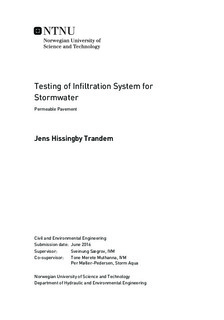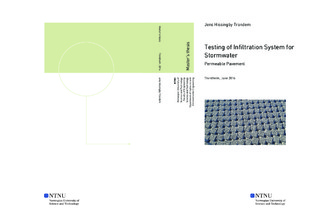| dc.description.abstract | In this master thesis it is focused on permeable pavement and with an extra focus on permeable interlocking concrete unit blocks as the type of pavement. This is because the test facility in Sandnes is built with this type of pavement, and all the data collected and used in the master thesis is from this test facility. The measurements started in May 2015 and parameters like air temperature, ground temperature, precipitation intensity, air pressure, wind speed, wind direction, water level in the infiltration basins and excess flow from the permeable areas are continuously registered in the system.
The different parts of the test facility from construction of the permeable pavement to the instrumentations used for collecting data are described in detail. Test area 1 and 2 is the access road and are only infiltrating water from the area they cover, which is 2 x 120m2. Test area 3 is 104m2 and infiltrates water from an impermeable part of the parking area of 1250m2.
The test facility have been doing constant registrations of data since the time of construction, but they were not controlled to see if the quality were good and if they were useful and could give some indications of the behavior of the permeable pavement. The potential evaporation from the permeable pavement is calculated and events with inflow to the infiltration basins in connection to the permeable test areas are analyzed.
The saturated hydraulic conductivity was measured for one of the test areas after almost a year without any maintenance since the construction. When the openings in the joint filling material remained untouched the infiltration rate was measured to be 78.9 cm/h and 107.2 cm/h. The upper 5 cm of the joint filling material were removed and the infiltration was measured to be 554.6 670.9 cm/h. The results show indication of fine particles in the upper 5 cm of the joint filling material clogging the pavement. The grain size distribution analyses show that 10 % of the weighted joint filling material had a smaller diameter than 2 mm.
The infiltration capacity was calculated for different rainfall events where inflow to SF2 was registered. The calculated infiltration capacities are lower than the measured infiltration capacity, but the time of the year might have affected the permeable pavement. Most of the calculated values for infiltration rate are from December to February, while the measurements were done in April. | |

